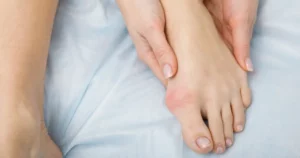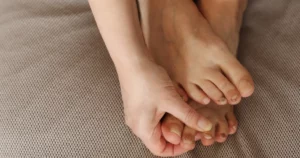
Table of Contents
Ingrown toenails are common foot conditions that can seriously impair everyday activities and cause significant discomfort. If you’ve ever experienced the pain and swelling associated with this condition, you’ll understand the importance of prevention.
For residents in Lorain, OH, understanding the causes, prevention strategies, and treatment options is crucial to maintaining healthy feet.
This comprehensive guide will explore the best footwear and nail care practices to prevent ingrown toenails. We’ll also discuss treatment options for those suffering from this condition and provide actionable steps to ensure your feet stay pain-free.
Understanding Ingrown Toenails
What Are Ingrown Toenails?
Redness, soreness, swelling, and occasionally infection are symptoms of an ingrown toenail, which happens when the nail’s edge pushes into the surrounding skin. The big toe is most commonly affected, though any toe can develop this condition.
Common Ingrown Toenail Causes
Several factors can lead to ingrown toenails, including:
- Improper Nail Trimming: Rounding the edges or cutting toenails too short might promote the growth of the nail into the skin.
- Tight Footwear: Shoes that squeeze the toes can force the nails into the skin.
- Injury: Trauma to the toe, such as stubbing it or dropping something heavy on it, can alter nail growth.
- Genetics: A natural curve in your nails may predispose you to this condition.
- Poor Foot Hygiene: Keeping your feet clean and dry is essential to prevent infections that can exacerbate ingrown toenails.
Preventing Ingrown Toenails: Nail Care Practices
Proper nail care is one of the most effective ways to prevent ingrown toenails. Here are essential tips to incorporate into your routine:
Trim Your Nails Correctly
Avoid cutting your nails too short or rounding the edges. Instead, trim them straight and use a nail file to smooth sharp edges. This method helps prevent the nail from growing into the surrounding skin.
Keep Your Nails Clean
Wash your feet regularly with soap and water to ensure the nails are free from dirt and bacteria. Dry your feet thoroughly to reduce the risk of fungal infections, which can contribute to nail issues.
Avoid Picking at Your Nails
Resist the urge to pull or tear your nails, which can cause irregular growth and increase the likelihood of ingrown toenails.
Monitor Nail Changes
Inspect your nails regularly for abnormal growth, discoloration, or swelling. Early detection can help you address potential issues before they worsen.
Choosing the Best Footwear to Prevent Ingrown Toenails
The kind of shoes you wear has a significant impact on avoiding ingrown toenails. Here’s how to choose footwear that will keep your feet safe:
Opt for Properly Fitting Shoes
Too tight shoes can compress your toes and force the nails into the skin. Conversely, overly loose shoes can cause your feet to slide forward, leading to repeated trauma to the toes.
Prioritize Breathability
Choose shoes made of breathable fabrics to keep your feet dry and lower your risk of infection.
Look for a Wide Toe Box
Your toes may move freely in shoes with a large toe box, which relieves strain on your nails.
Avoid High Heels and Pointed Toes
Frequent use of high heels and pointed-toe shoes can crowd your toes, increasing the likelihood of ingrown toenails. Save these styles for special occasions.
Use Protective Footwear for Activities
Wear sturdy, closed-toe shoes or steel-toe boots to prevent injuries if your job or hobbies expose your feet to potential trauma.
Additional Prevention Tips
Practice Good Foot Hygiene
Regularly clean and exfoliate your feet to prevent dead skin and buildup of bacteria. This practice reduces the chances of infections that can worsen ingrown toenails.
Moisturize Your Feet
Dry skin can crack and create openings for bacteria, so keep your feet moisturized. Use a non-greasy foot lotion to maintain hydration without encouraging fungal growth.
Wear Socks That Fit Well
Tight socks can compress your toes, while loose socks may bunch up and create friction.
Consider Orthotics
Custom orthotics, which offer extra alignment and support, can help avoid ingrown toenails and lessen strain on your toes.
Treating Ingrown Toenails
Despite your best efforts, you may still develop an ingrown toenail. Here’s what to do if you’re in Lorain, OH, and need treatment:
Home Remedies
- Soak Your Feet: Soak your feet in warm water with Epsom salt for 15-20 minutes, three times daily. This can reduce swelling and soften the skin.
- Use Antibacterial Cream: Apply an over-the-counter antibacterial cream to prevent infection.
- Lift the Nail: To promote healthy growth, gently lift the nail’s edge and insert a tiny piece of cotton or dental floss underneath.
Professional Ingrown Toenail Treatment
If home remedies don’t relieve or the condition worsens, seek professional help. A podiatrist can:
- Trim the Nail Properly: Safely remove the ingrown portion of the nail.
- Prescribe Antibiotics: Address infections caused by ingrown toenails.
- Perform Ingrown Toenail Surgery: In severe cases, a minor surgical procedure may be necessary to remove part or all of the nail.
Frequently Asked Questions (FAQs) About Ingrown Toenails
Can ingrown toenails heal on their own?
In some cases, mild ingrown toenails may resolve with proper home care, such as soaking the feet and keeping the area clean. However, persistent or severe cases often require professional treatment to prevent complications.
What should I do if my ingrown toenail is infected?
You must see a podiatrist if you notice signs of infection, such as redness, swelling, pain, or pus. They can prescribe antibiotics and perform necessary procedures to treat the condition.
Can children get ingrown toenails?
Yes, children can develop ingrown toenails, especially if they wear tight shoes or cut their nails improperly. Teaching them good nail care habits early can help prevent this condition.
How long does it take to recover from ingrown toenail surgery?
Most people recover within a few weeks after ingrown toenail surgery. Following your doctor’s post-operative care instructions will ensure a smooth and speedy recovery.
Conclusion
Preventing ingrown toenails is achievable with the proper footwear and nail care practices. You can significantly reduce your risk of developing this painful condition by trimming your nails correctly, wearing supportive shoes, and maintaining proper foot hygiene.
However, if you’re already experiencing discomfort, don’t wait for it to worsen. Schedule an appointment today to treat your ingrown toenail. Our experienced team at Integrity Foot and Ankle Associates is here to provide practical solutions and help you achieve optimal foot health.
If you have any questions or concerns, contact Integrity Foot and Ankle Associates. We’re dedicated to helping you stay on your feet, pain-free and confident, every step of the way.




